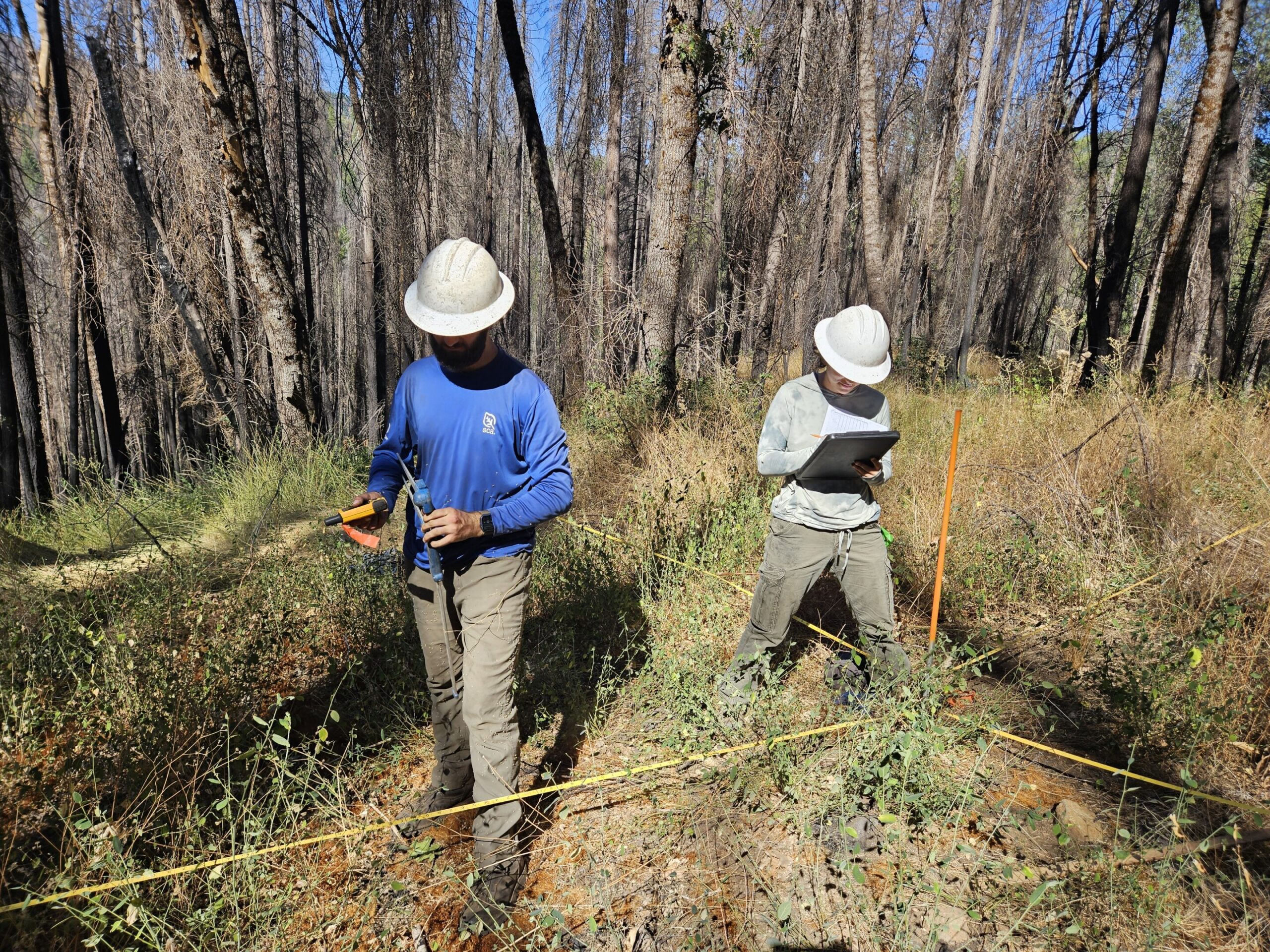
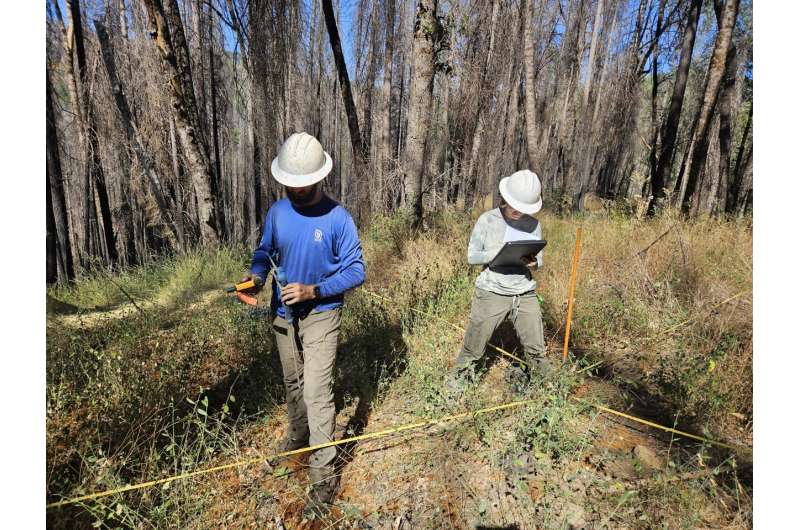
Charred trees punctuated the Eldorado National Forest like blackened skeletons of their former selves, victims of the Mosquito Fire. Two years earlier, in 2022, the Mosquito Fire started in Tahoe National Forest, moved north to the Eldorado and torched a total of 76,788 acres, making it California’s largest wildfire in 2022.
For me, the sight of those burned trees was shocking. But for USDA Forest Service biological science technicians, Avery Sigarroa and Adam Wood, mapping and gathering data about the scorched landscape was part of their job.
“That data will inform a long-term study of how the Eldorado is faring, years after the Mosquito Fire struck in 2022, capturing points in time” Sigarroa, who also served as crew lead, explained.
September 2024 marked the end of their season in which they had recorded data on plants and wildlife in 60 plots in the Mosquito Fire’s footprint. That data will contribute to a long-term study that looks at the health of burned forests over time.
Researchers with diverse specialties will comb through that information to see what wildlife is coming back or visiting the forest, what plants are growing there, the ability of trees to regenerate after a wildfire and more. Looking at large swaths of land, they will compare areas where logging has occurred to those left untreated. Compiling these findings, will give researchers a sense of what’s happening to scorched forests and the life they sustain over time.
Thinking of this, I trailed behind Sigarroa and Wood, following them deeper into the forest to our plot. When we arrived, Wood hiked off to retrieve a wildlife camera, and set up acoustic bat and birdsong devices that recorded the animals’ distinctive calls. Later, scientists will sort through that data to distinguish each species by sound.
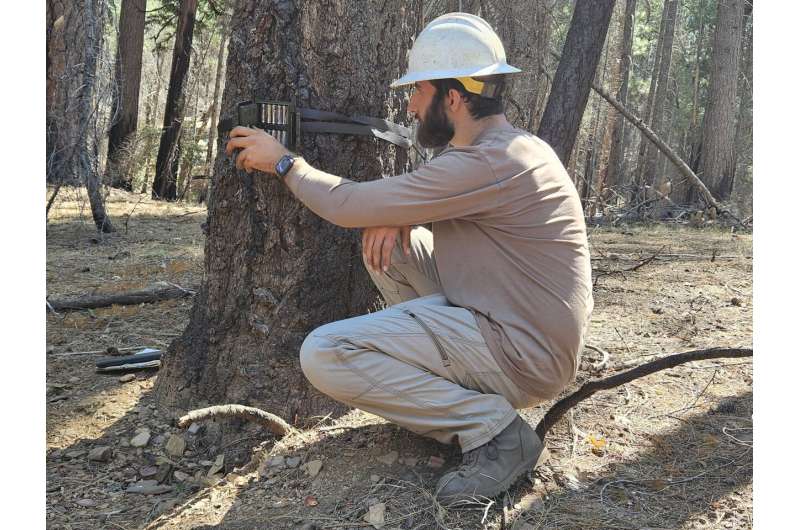
While Wood focused on the wildlife, Sigarroa placed a stake in the ground with four tape measures over it. Using a compass, she unraveled and walked with each tape in the four cardinal directions—north, south, east and west—marking 66, 58.9 and 24 feet with orange and blue flagging. My job was to measure the circumference of the trees that fell within these transects or divided sections.
As Sigarroa set up the plots, I noticed something I never expected to see in a scorched landscape—signs of life. A butterfly flitted by flashing vibrant orange patches on either wing. A woodpecker drummed on a ponderosa pine and seedlings—baby trees—encircled some of their burned parents.
“Look!” Sigarroa said, excitedly, pointing to a nearby sugar pine. A black bear’s claw marks etched the tree’s bark. The furry mammal also left a calling card by the foot of the tree in the form of scat or dung filled with berries, suggesting the bear enjoyed dining in the forest.
After marveling over the bear’s presence, we returned to our tasks. Rubbing my hand over the platted bark of the ponderosa pine, I gazed up at its towering canopy of evergreen needles that reached to the sky. Maybe this one will survive, I thought, wishing the tree well.
I held a puck against the tree, a circular object, in Sigarroa’s line of sight. They aimed a square device—a hypsometer— at the center of the puck, which relayed the tree’s height.
Placing the edge of the tape measure in the furrow of the tree’s bark to keep it in place, I walked around the base of the tree, pulling the tape tightly around it.
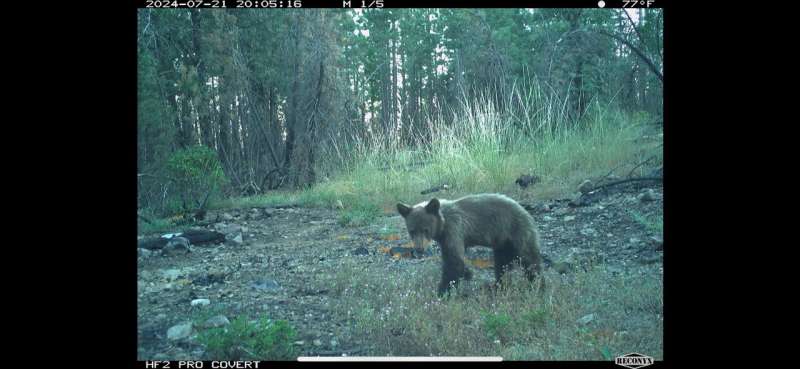
“31,” I announced, and Sigarroa jotted down the tree’s circumference. “The minimum burn height is about a foot and the maximum is 17 feet,” I added. Then, I was off to the next tree.
Measuring trees and determining fire effects took me a little time to get the hang of, and the sun’s heat sapped my energy. But after a while, the work took on a rhythmic quality.
Soot covered my clothes and coated my face, as I measured ponderosa pines, incense cedars, white firs, sugar pines, black oaks and Douglas firs. The more trees I measured, the deeper my connection to them grew. Wrapping my arms around their girth, I felt a connection to a living thing that provided shade, oxygen and wildlife habitat.
The physical nature of the work was rewarding, and the hours peeled away. I rolled up the tape measures, while Sigarroa pounded orange conduit into the ground to mark where we surveyed.
“Five years later the next crew can compare our results to what they find. This will provide a real-time snapshot of how the forest is faring,” Sigarroa said.
I thought of this, as I rested on a burned log, serving as a makeshift seat with Sigarroa and Wood. Charismatic wildlife, captured on a motion sensor camera, captivated our attention. Scrolling through photos, we admired a fawn staring into the camera, a fox wandering by, a mountain lion lurking, and a mamma bear running with two cubs in tow.
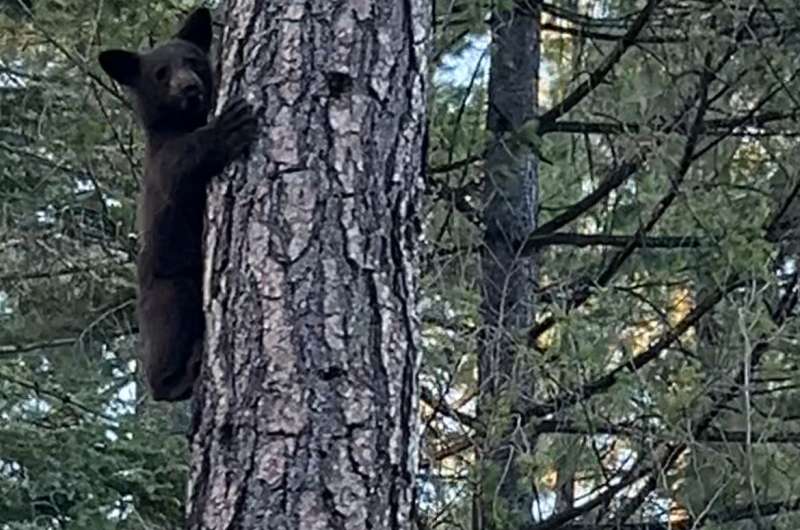
Buoyed by the wildlife photos, we packed our equipment, took a swig of water, and started the quarter of a mile hike back to the truck to drive to our backcountry campsite.
Darkness descended quickly and soon we sat in camping chairs under a sea of stars in an inky sky, enjoying the silence and peace, watching bats dart back and forth.
Wood and Sigarroa spoke animatedly about their experiences. Wood received a bachelor’s degree in biology with a concentration in ecology from Cal Poly Humboldt. Sigarroa earned an undergraduate degree from the University of Nevada, Reno with a double major in conservation wildlife ecology and environmental science.
Along with their affinity for science, both shared a passion for the outdoors. Previously, Wood worked for the Forest Service in Montana using hand tools to cut down trees in the wilderness. While Wood was clearing trees, Sigarroa was monitoring desert springs, analyzing water quality and more, for the National Park Service’s Mojave Desert Inventory and Monitoring Network.
“I feel proud of the work we’re doing on the Eldorado and how it can inform research on making forests more resilient for the future for all of us,” Wood said. Sigarroa nodded in agreement.
Listening to Wood and Sigarroa, I felt privileged to be part of their team, even if only briefly.
Provided by
USDA Forest Service
Citation:
Field notes: Life in the Eldorado National Forest after wildfire strikes (2024, October 5)
retrieved 5 October 2024
from https://phys.org/news/2024-10-field-life-eldorado-national-forest.html
This document is subject to copyright. Apart from any fair dealing for the purpose of private study or research, no
part may be reproduced without the written permission. The content is provided for information purposes only.